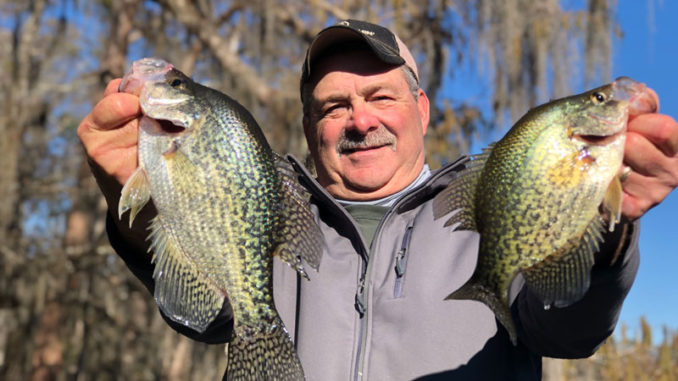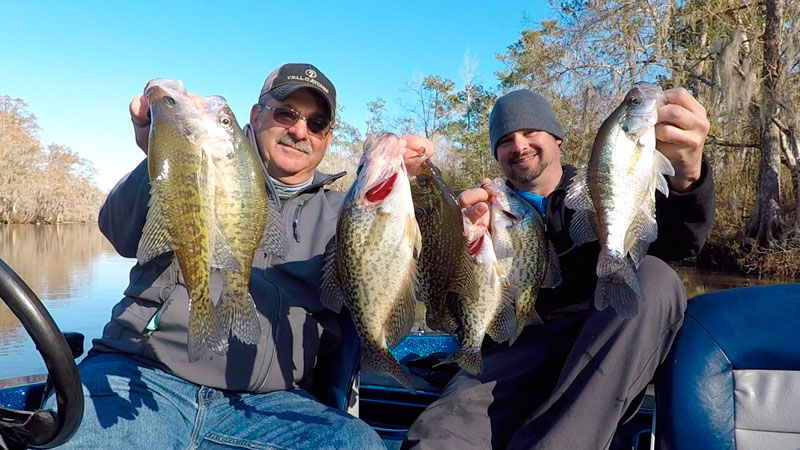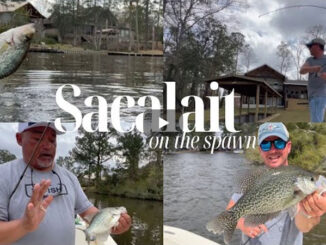
The rivers that span the Northshore are home to some of the best waterways in Louisiana, for producing sac-a-lait. Originally from Luling, Tim Bye has started fishing the Tchefuncte River since moving to Folsom recently, and he said the deep, winding river has plenty to offer crappie anglers.
“I believe this river has the most sac-a-lait per square foot of water in the entire state,” he said.
With warming temperatures, Bye said it’s all about the spawn in March. However, while most anglers will be putting corks on their lines, looking to target the shoreline in less than 3 feet of water, Bye sticks with what works for him.
“I fish crappie year-round, so I like to let them do their thing in the shallows when the water warms up into the 60s,” he said.
Bye’s preferred style of fishing is deep-jigging rather than using corks in the shallows.
“Most people think the spawn happens all at once, but I find that there are different sections of the river that warm up faster than others,” Bye said. “Also, these fish don’t take as long as people think to do their thing. I find that it’s only three or four days that a pair will be in the shallows and they’re heading back out.”
Just as sure as you can bet on each fish being in the shallows once a year, you can bet on those fish being in staging areas and post-spawn areas.
“These fish have to eat to stay alive, and I find that they feed best before the spawn and after, he said. “During the spawn, their priority is to bed, and feeding becomes less important.”
Bye said he’ll fish two patterns during the spawn, allowing him to take advantage of both prespawn and post-spawn sac-a-lait.
Prespawn staging
As water temperatures approach the lower 60s for a few days, sac-a-lait will start to move into the entrances of canals and smaller bayous that feed into the main river. Bye said he’s finding fish consistently in early March, but don’t expect to hit the mother load in one spot.

“I find that the fish that are staging are a bit more spread out,” he said. “I’ll pick up one or two in each spot in 6 to 10 feet of water.”
For prespawn slabs, Bye uses a 9-foot crappie pole with a spin-cast reel. He prefers a 9-foot rod over a 10-footer because it allows him to flip his jig outwards a few feet instead of being limited to jigging straight down. As far as lures go, he rigs a 1/32-ounce head on 8-pound test and threads on a blue/chartreuse Scale Head tube jig made by Lil’ Hustler. Bye makes a small adjustment to the jig however.
“I like to take my pocket knife and slice the head of the tube off so the body fits flush up against the jighead,” he said.
Post-spawn retreat
While the sac-a-lait spawn seems to last four to six weeks, Bye has seen fish heading back to deep water as early as the end of February.
“It doesn’t take them long; once they’re done, they’re back out to deeper water where they spend the majority of the year feeding,” he said.
Crappie are known as feeding machines, and after they are finished spawning, they feed non-stop.
“When they are done with the spawn, these fish are hungry!” Bye said. “I compare the way they eat after the spawn to November, which is probably the month that they feed the best here on the Tchefuncte.
While Bye stays out of the shallows, he admits that finding the right canal in March could make for a big day to fill the ice chest.
“There’s no doubt you can put a hurtin’ on ‘em if you find the right shoreline,” he said. “I’ve seen some really nice boxes taken from this river with just a jig with a cork from guys beating the bank.”


